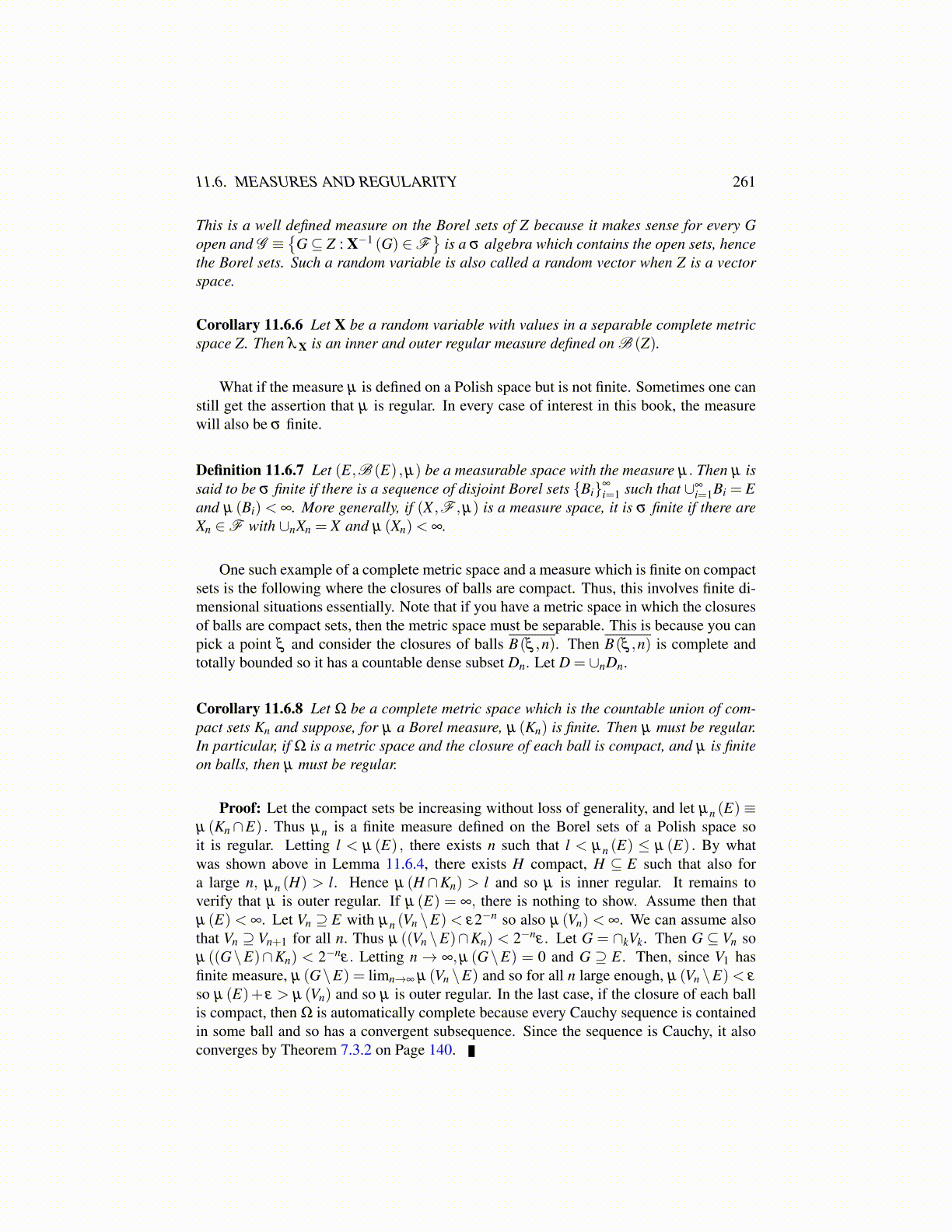
11.6. MEASURES AND REGULARITY 261
This is a well defined measure on the Borel sets of Z because it makes sense for every Gopen and G ≡
{G⊆ Z : X−1 (G) ∈F
}is a σ algebra which contains the open sets, hence
the Borel sets. Such a random variable is also called a random vector when Z is a vectorspace.
Corollary 11.6.6 Let X be a random variable with values in a separable complete metricspace Z. Then λ X is an inner and outer regular measure defined on B (Z).
What if the measure µ is defined on a Polish space but is not finite. Sometimes one canstill get the assertion that µ is regular. In every case of interest in this book, the measurewill also be σ finite.
Definition 11.6.7 Let (E,B (E) ,µ) be a measurable space with the measure µ. Then µ issaid to be σ finite if there is a sequence of disjoint Borel sets {Bi}∞
i=1 such that ∪∞i=1Bi = E
and µ (Bi) < ∞. More generally, if (X ,F ,µ) is a measure space, it is σ finite if there areXn ∈F with ∪nXn = X and µ (Xn)< ∞.
One such example of a complete metric space and a measure which is finite on compactsets is the following where the closures of balls are compact. Thus, this involves finite di-mensional situations essentially. Note that if you have a metric space in which the closuresof balls are compact sets, then the metric space must be separable. This is because you canpick a point ξ and consider the closures of balls B(ξ ,n). Then B(ξ ,n) is complete andtotally bounded so it has a countable dense subset Dn. Let D = ∪nDn.
Corollary 11.6.8 Let Ω be a complete metric space which is the countable union of com-pact sets Kn and suppose, for µ a Borel measure, µ (Kn) is finite. Then µ must be regular.In particular, if Ω is a metric space and the closure of each ball is compact, and µ is finiteon balls, then µ must be regular.
Proof: Let the compact sets be increasing without loss of generality, and let µn (E) ≡µ (Kn∩E) . Thus µn is a finite measure defined on the Borel sets of a Polish space soit is regular. Letting l < µ (E) , there exists n such that l < µn (E) ≤ µ (E) . By whatwas shown above in Lemma 11.6.4, there exists H compact, H ⊆ E such that also fora large n, µn (H) > l. Hence µ (H ∩Kn) > l and so µ is inner regular. It remains toverify that µ is outer regular. If µ (E) = ∞, there is nothing to show. Assume then thatµ (E) < ∞. Let Vn ⊇ E with µn (Vn \E) < ε2−n so also µ (Vn) < ∞. We can assume alsothat Vn ⊇ Vn+1 for all n. Thus µ ((Vn \E)∩Kn) < 2−nε . Let G = ∩kVk. Then G ⊆ Vn soµ ((G\E)∩Kn) < 2−nε. Letting n→ ∞,µ (G\E) = 0 and G ⊇ E. Then, since V1 hasfinite measure, µ (G\E) = limn→∞ µ (Vn \E) and so for all n large enough, µ (Vn \E)< ε
so µ (E)+ ε > µ (Vn) and so µ is outer regular. In the last case, if the closure of each ballis compact, then Ω is automatically complete because every Cauchy sequence is containedin some ball and so has a convergent subsequence. Since the sequence is Cauchy, it alsoconverges by Theorem 7.3.2 on Page 140.